Catalytic Properties and Recycling of NiFe2O4 Catalyst for Hydrogen Production by Supercritical Water Gasification of Eucalyptus Wood Chips
Abstract
1. Introduction
2. Experimental
2.1. Material
2.2. Synthesis and Characterization of Catalyst
2.3. Catalytic SCWG Test with NiFe2O4
3. Results and Discussion
3.1. Characterization of the Fresh Catalyst
3.2. Catalytic testing of NiFe2O4 for SCWG of Eucalyptus Chips
3.3. Catalyt Recycling
4. Conclusions
Author Contributions
Funding
Acknowledgments
Conflicts of Interest
References
- Borges, A.C.P.; Alves, C.T.; Andrade, H.M.C.; Ingram, A.; Vieira de Melo, S.A.B.; Torres, E.A. Supercritical water gasification of Eucalyptus wood chips using NiFe2O4 as a catalyst. In Proceedings of the ICPRE 2018-3rd International Conference on Power and Renewable Energy, Berlin, Germany, 21–24 September 2018; E3S Web of Conferences. Volume 64, p. 010002. [Google Scholar] [CrossRef]
- Rodriguez Correa, C.; Kruse, A. Supercritical water gasification of biomass for hydrogen production—Review. J. Supercrit. Fluids 2018, 133, 573–590. [Google Scholar] [CrossRef]
- Guo, Y.; Wang, S.Z.; Xu, D.H.; Gong, Y.M.; Ma, H.H.; Tang, X.Y. Review of catalytic supercritical water gasification for hydrogen production from biomass. Renew. Sustain. Energy Rev. 2010, 14, 334–343. [Google Scholar] [CrossRef]
- Okalie, J.A.; Rana, R.; Nanda, S.; Dalai, A.K.; Kozinski, J.A. Supercritical water gasification of biomass: A state-of-the-art review of process parameters, reaction mechanisms and catalysis. Sustain. Energy Fuels 2019, 3, 578–598. [Google Scholar] [CrossRef]
- Ding, N.; Azargohar, R.; Dalai, A.K.; Kozinski, J.A. Catalytic gasification of cellulose and pinewood to H2 in supercritical water. Fuel 2014, 118, 416–425. [Google Scholar] [CrossRef]
- Sheikhdavoodi, M.J.; Almassi, M.; Ebrahimi-Nik, M.; Kruse, A.; Bahrami, H. Gasification of sugarcane bagasse in supercritical water; evaluation of alkali catalysts for maximum hydrogen production. J. Energy Inst. 2015, 88, 450–458. [Google Scholar] [CrossRef]
- Ge, Z.; Jin, H.; Guo, L. Hydrogen production by catalytic gasification of coal in supercritical water with alkaline catalysts: Explore the way to complete gasification of coal. Int. J. Hydrog. Energy 2014, 39, 19583–19592. [Google Scholar] [CrossRef]
- Yoshida, T.; Oshima, Y.; Matsumura, Y. Gasification of Biomass Model Compounds and Real Biomass in Supercritical Water. Biomass Bioenergy 2004, 26, 71–78. [Google Scholar] [CrossRef]
- Sealock, L.J., Jr.; Elliott, D.C. Method for the Catalytic Conversion of Lignocellulosic Materials. U.S. Patent 5,019,135, 28 May 1991. [Google Scholar]
- Yamaguchi, A.; Hiyoshi, N.; Sato, O.; KBando, K.; Osada, M.; Shirai, M. Hydrogen production from woody biomass over supported metal catalysts in supercritical water. Catal. Today 2009, 146, 192–195. [Google Scholar] [CrossRef]
- Lu, Y.; Li, S.; Guo, L. Chapter 13: Catalysis in Supercritical Water Gasification of Biomass: Status and Prospects. In Near-Critical and Supercritical Water and Their Applications for Biorefineries, Biofuels and Biorefineries, 2nd ed.; Fang, Z., Xu, C., Eds.; Springer-Science+Business Media Dordrecht: New York, NY, USA; London, UK, 2014. [Google Scholar]
- Li, S.; Guo, L. Stability and activity of a co-precipitated Mg promoted Ni/Al2O3 catalyst for supercritical water gasification of biomass. Int. J. Hydrog. Energy 2019, 44, 15842–15852. [Google Scholar] [CrossRef]
- Elliot, D.C. Catalytic hydrothermal gasification of biomass. Biofuels Bioprod. Biorefin. 2008, 2, 254–265. [Google Scholar] [CrossRef]
- Elliot, D.C.; Sealock, L.J., Jr.; Baker, E.G. Chemical processing in high-pressure aqueous environments. Development of catalyst for gasification. Ind. Eng. Chem. Res. 1993, 32, 1542–1548. [Google Scholar] [CrossRef]
- Waldner, M.H.; Vogel, F. Renewable production of methane from woody biomass by catalytic hydrothermal gasification. Ind. Eng. Chem. Res. 2005, 44, 4543–4551. [Google Scholar] [CrossRef]
- Furusawa, T.; Sato, T.; Saito, M.; Ishiyama, Y.; Sato, M.; Itoh, N.; Suzuki, N. The evaluation of the stability of Ni/MgO catalysts for the gasification of lignin in supercritical water. Appl. Catal. A Gen. 2007, 327, 300–310. [Google Scholar] [CrossRef]
- Furusawa, T.; Sato, T.; Sugito, H.; Miura, Y.; Ishiyama, Y.; Sato, M.; Itonh, N.; Suzuki, N. Hydrogen production from the gasification of lignin with nickel catalysts in supercritical water. Int. J. Hydrog. Energy 2007, 32, 699–704. [Google Scholar] [CrossRef]
- Maltha, A.; Kist, H.F.; Brunet, B.; Ziolkwski, J.; Onishi, H.; Iwasawa, Y.; Ponec, V. The sites of manganese-and-cobalt containing catalysts in the seletive gas phase reduction of nitrobenzene. J. Catal. 1994, 149, 356–363. [Google Scholar] [CrossRef]
- Doppler, G.; Trautwein, A.X.; Ziethen, H.M.; Ambach, E.; Lehnert, R.; Sorague, M.; Gonser, U. Physical and catalytic Properties of high-temperature water-gas shift catalysts based upon iron-chromium oxides. Appl. Catal. 1988, 40, 119–130. [Google Scholar] [CrossRef]
- Lelis, M.F.F.; Menini, L.; da Silva, M.J.; Fabris, J.D.; Lago, R.M.; Gusevskwysa, E.V. Novel solvent free liquid-phase oxidation of [beta]-pinene over heterogeneous catalysts based on Fe3−xMxO4 (M=Co and Mn). Appl. Catal. A Gen. 2004, 269, 117–121. [Google Scholar]
- Oliveira, L.C.A.; Fabris, J.D.; Rios, R.R.V.A.; Mussel, W.N.; Lago, R.M. Fe3−xMxO4 catalysts: Phase transformations and carbon monoxide oxidation. Appl. Catal. A Gen. 2004, 259, 253–259. [Google Scholar] [CrossRef]
- Costa, A.C.F.M.; Lula, R.T.; Kiminami, R.H.G.A.; Gama, L.F.V.; de Jesus, A.A.; Andrade, H.M.C. Preparation of nanostructured NiFe2O4 catalysts by combustion reaction. J. Mater. Sci. 2005, 41, 4871–4875. [Google Scholar] [CrossRef]
- Benrabaa, R.; Lofberg, A.; Caballero, J.G.; Bordes-Richards, E.; Rubbens, A.; Vannier, R.N.; Boukhlouf, H.; Barama, A. Sol–gel synthesis and characterization of silica supported nickel ferrite catalysts for dry reforming of methane. Catal. Commun. 2015, 58, 127–131. [Google Scholar] [CrossRef]
- Pannaparayil, T.; Marande, R.; Komarneni, S.; Sankar, S.G. A novel low-temperature preparation of several ferrimagnetic spinels and their magnetic and Mössbauer characterization. J. Appl. Phys. 1988, 64, 5641. [Google Scholar] [CrossRef]
- Alves, C.T.; Oliveira, A.; Carneiro, S.A.V.; Silva, A.G.; Andrade, H.M.C.; Vieira de Melo, S.A.B.; Torres, E.A. Transesterification of waste frying oil using a zinc aluminate catalyst. Fuel Process. Technol. 2013, 106, 102–107. [Google Scholar] [CrossRef]
- Patil, K.C.; Hedge, M.S.; Rattan, T.; Aruna, S.T. Chemistry of Nanocrystalline Oxide Materials, Combustion Synthesis, Properties and Applications; Word Scientific Pub: Singapore, 2008. [Google Scholar]
- Borges, A.C.P.; Onwuidili, J.A.; Andrade, H.M.C.; Alves, C.T.; Ingram, A.; Vieira de Melo, S.A.B.; Torres, E.A. Catalytic supercritical water gasification of eucalyptus wood chips in a batch Reactor. Fuel 2019, 255, 115804–115813. [Google Scholar] [CrossRef]
- Borges, A.C.P.; Alves, C.T.; Torres, E.A. Torrefied Eucalyptus Grandis Characterization as a Biomass to Using in Industrial Scale. Chem. Eng. Trans. 2016, 49, 283–288. [Google Scholar]
- González-Cortés, S.L.; Imbert, F.E. Fundamentals, properties and applications of solid catalysts prepared by solution combustion synthesis (SCS). Appl. Catal. A Gen. 2013, 452, 117–131. [Google Scholar] [CrossRef]
- Klung, H.; Alexander, L. X-ray Diffraction Procedures; John Wiley & Sons: New York, NY, USA, 1962; p. 491. [Google Scholar]
- Degen, T.; Sadki, M.; Bron, E.; Konig, U.; Nénert, G. Powder Diffraction; Cambridge University: Cambridge, UK, 2014; Volume 29, pp. S13–S18. [Google Scholar]
- Lloyd, L.; Ridler, D.E.; Twigg, M.V. Catalyst Handbook, 2nd ed.; Wolfe: London, UK, 1989; p. 28. [Google Scholar]
- Wang, Z.; Shui, H.; Pan, C.; Li, L.; Ren, S.; Lei, Z.; Kang, S.; Wei, C.; Hu, J. Structural characterization of the thermal extracts of lignite. Fuel Process. Technol. 2014, 120, 8–15. [Google Scholar] [CrossRef]
- Duan, P.; Jin, B.; Xu, Y.; Yang, Y.; Bai, X.; Wang, F. Thermo-chemical conversion of Chlorella pyrenoidosa to liquid biofuels. Bioresour. Technol. 2013, 133, 197–205. [Google Scholar] [CrossRef]
- Prabhakaran, T.; Hemalatha, J. Combustion synthesis and characterization of highly crystalline single phase nickel ferrite nanoparticles. J. Alloys Compd. 2011, 509, 7071–7077. [Google Scholar] [CrossRef]
- Karakaş, Z.K.; Boncukçuoğlu, R.; Karakaş, I.H. The effects of fuel type in synthesis of NiFe2O4 nanoparticles by microwave assisted combustion method. J. Phys. Conf. Ser. 2016, 707, 012046. [Google Scholar] [CrossRef]
- Jones, A.; McNicoL, B.; Dekker, M. Temperature Programmed Reduction for Solid Materials Characterization; Chemical Industrial Series; CRC Press: Boca Raton, FL, USA, 1986; Volume 24. [Google Scholar]
- Venugopal, A.; Scurrell, M.S. Low temperature reductive pretreatment of Au/Fe2O3 catalysts, TPR/TPO studies and behaviour in the water-gas shift reaction. Appl. Catal. A 2004, 258, 241–249. [Google Scholar] [CrossRef]
- Jin, Y.; Datye, A.K. Phase transformations in iron Fischer-Tropsch catalysts during temperature-programmed reduction. J. Catal. 2000, 196, 8–17. [Google Scholar] [CrossRef]
- Thommes, M.; Kaneko, K.; Neimark, A.V.; Olivier, J.P.; Rodriguez-Reinoso, F.; Rouquerol, J.; Sing, K.S.W. Physisorption of gases, with special reference to the evaluation of surface area and pore size distribution (IUPAC Technical Report). Pure Appl. Chem. 2015, 87, 1051–1069. [Google Scholar] [CrossRef]
- Chen, D.H.; He, X.R. Synthesis of nickel ferrite nanoparticles by sol-gel method. Mater. Res. Bull. 2001, 38, 1369–1377. [Google Scholar] [CrossRef]
- Azadi, P.; Farnood, R. Review of heterogeneous catalysts for sub- and supercritical water gasification of biomass and wastes. Fuel Energy Abstr. 2011, 36, 9529–9541. [Google Scholar] [CrossRef]
- Susanti, R.F.; Dianningrum, L.W.; Yum, T.; Kim, Y.; Lee, B.; Kim, J. High-yield hydrogen production from glucose by supercritical water gasification without added catalyst. Int. J. Hydrog. Energy 2012, 37, 11677–11690. [Google Scholar] [CrossRef]
- Onwuidili, J.A. Supercritical water gasification of RDF and its components over RuO2/γ-Al2O3 catalyst: New insights into RuO2 catalytic reaction mechanisms. Fuel 2016, 181, 157–169. [Google Scholar] [CrossRef]
- Cortright, R.D.; Davda, R.R.; Dumesic, J.A. Hydrogen from catalytic reforming of biomass-derived hydrocarbons in liquid water. Nature 2002, 418, 964–967. [Google Scholar] [CrossRef]
- Argyle, M.D.; Bartholomew, C.H. Heterogeneous Catalyst Deactivation and Regeneration: A Review. Catalysts 2015, 5, 145–269. [Google Scholar] [CrossRef]
- Lu, Y.; Zhu, Y.; Li, S.; Zhang, X.; Guo, L. Behavior of nickel catalysts in supercritical water gasification of glucose: Influence of support. Biomass Bioenergy 2014, 67, 125–136. [Google Scholar] [CrossRef]
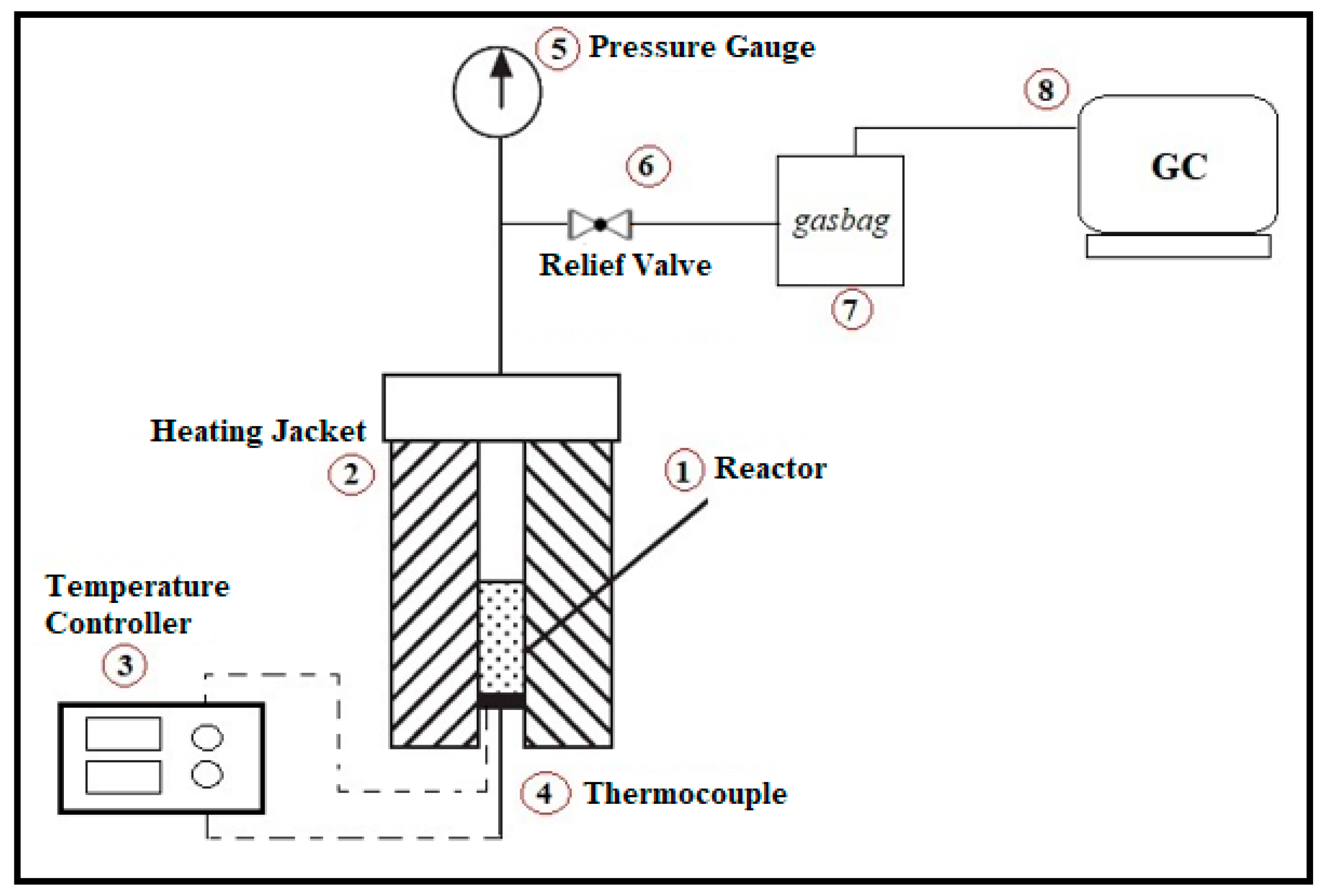

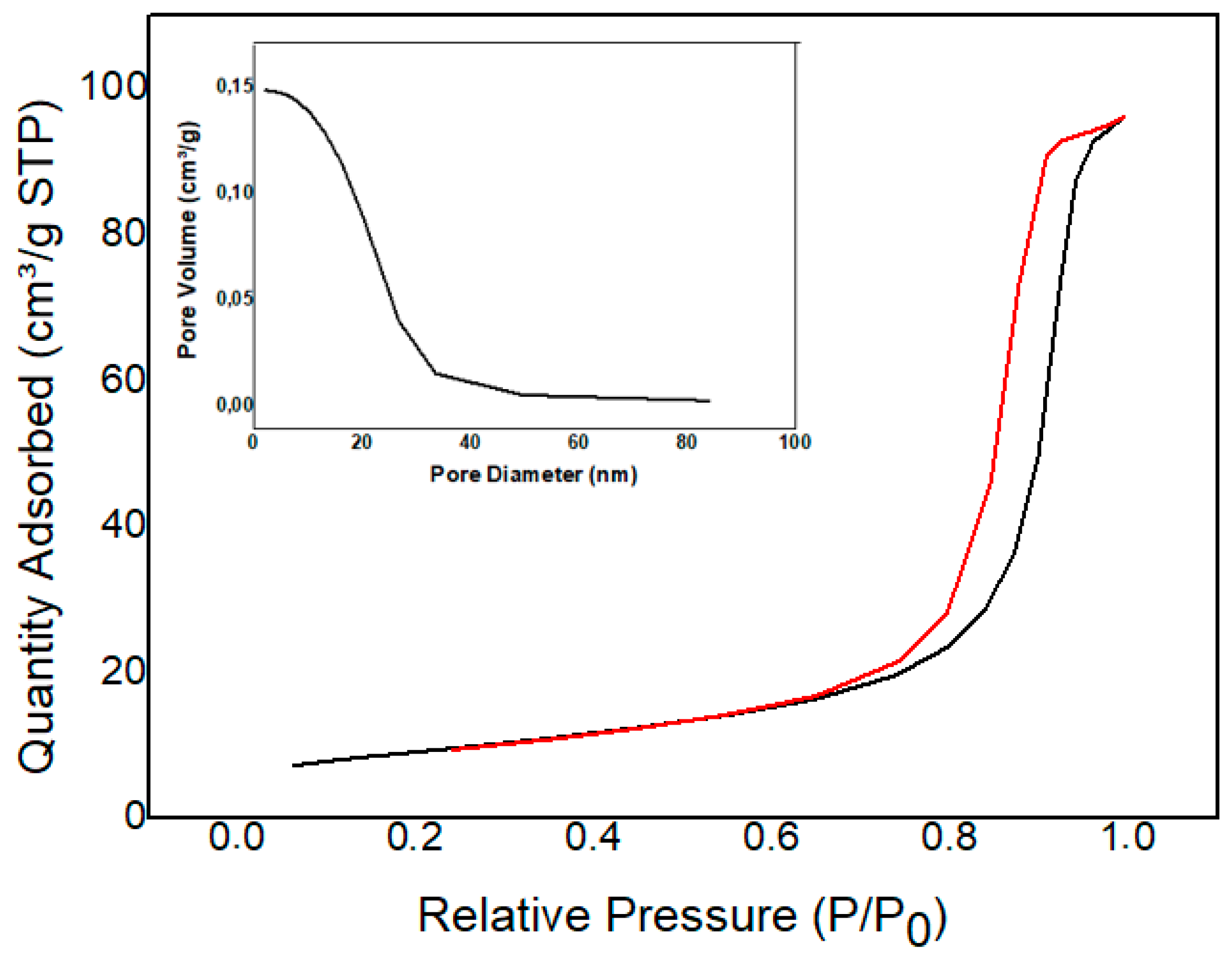
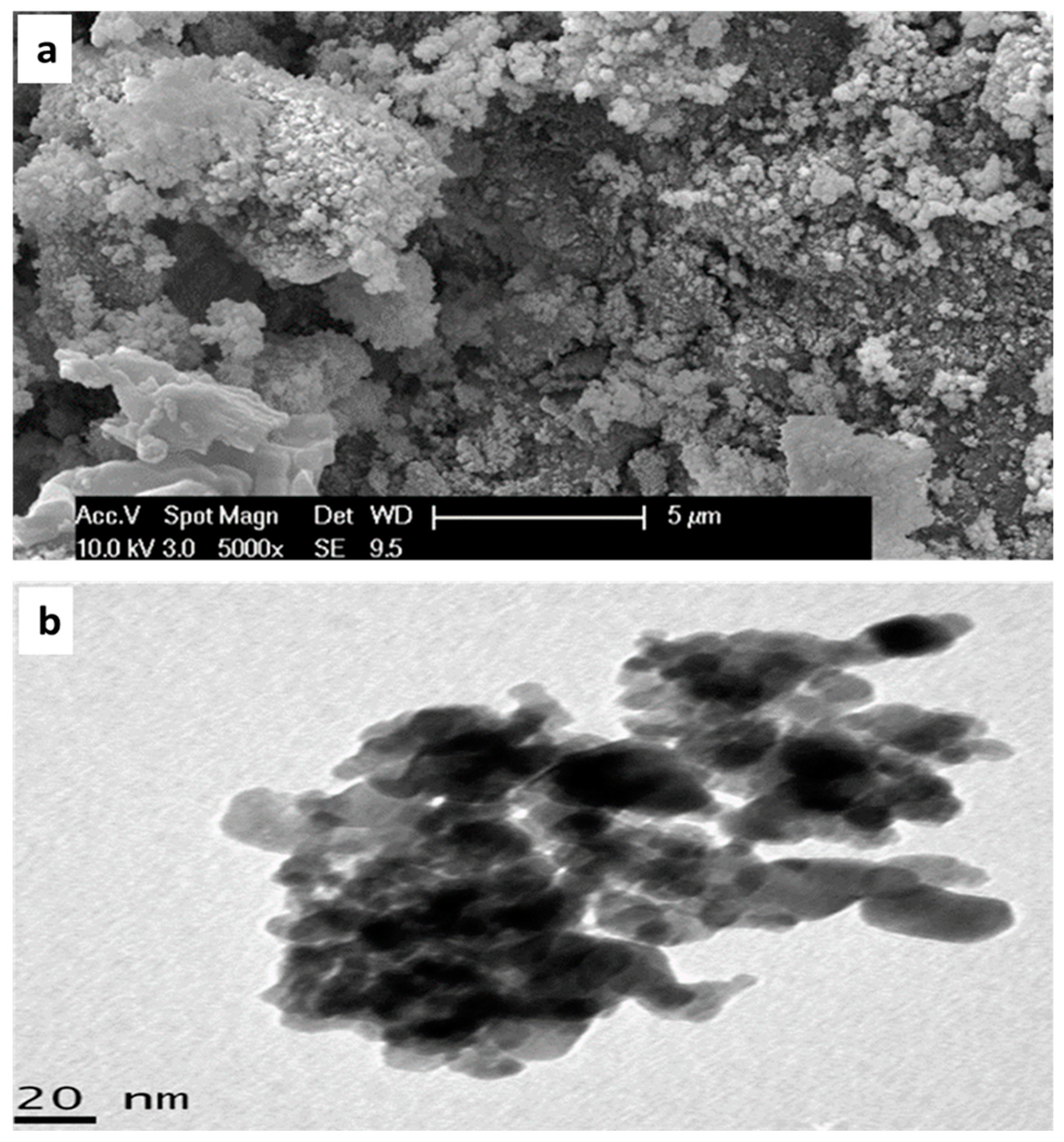
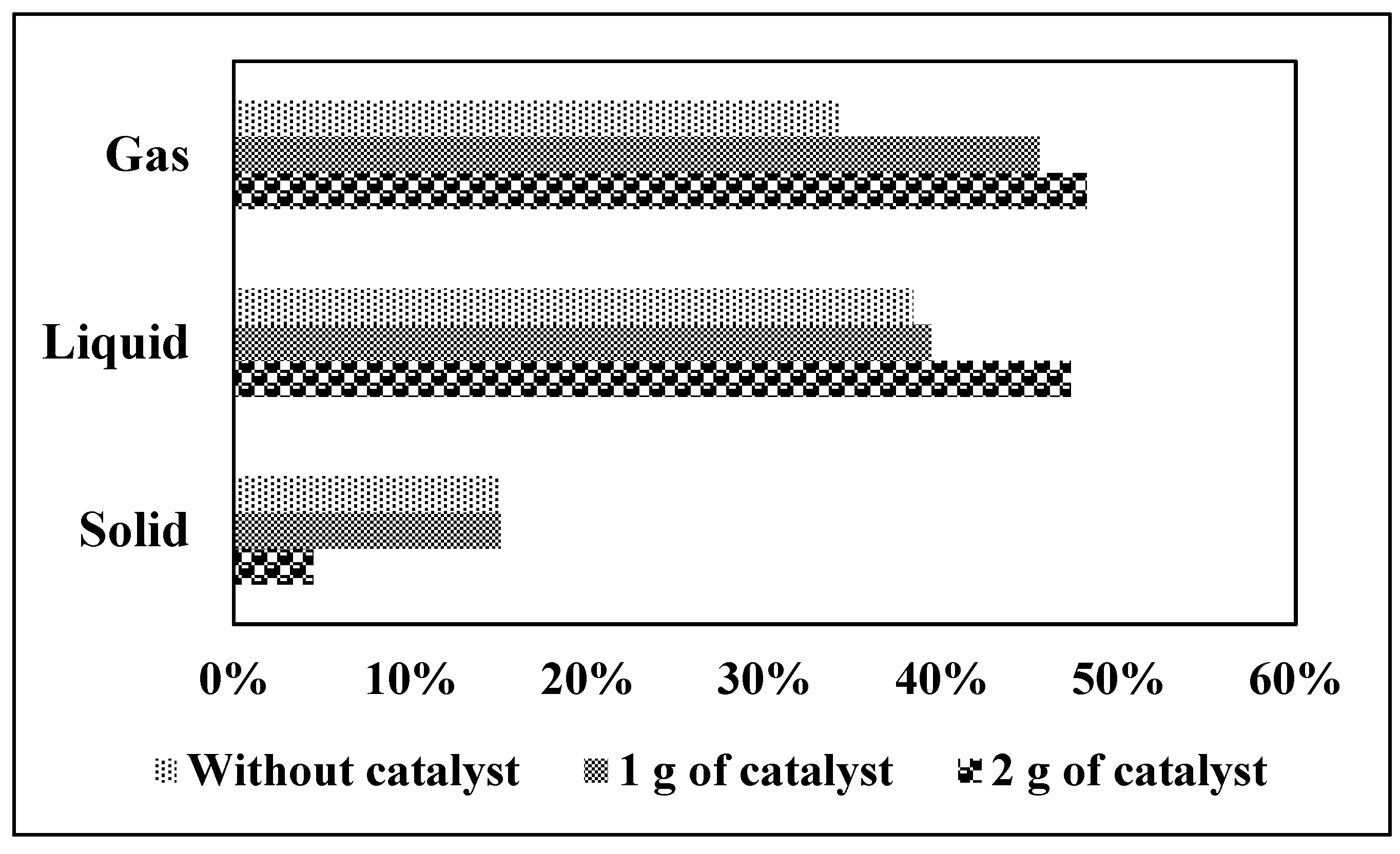
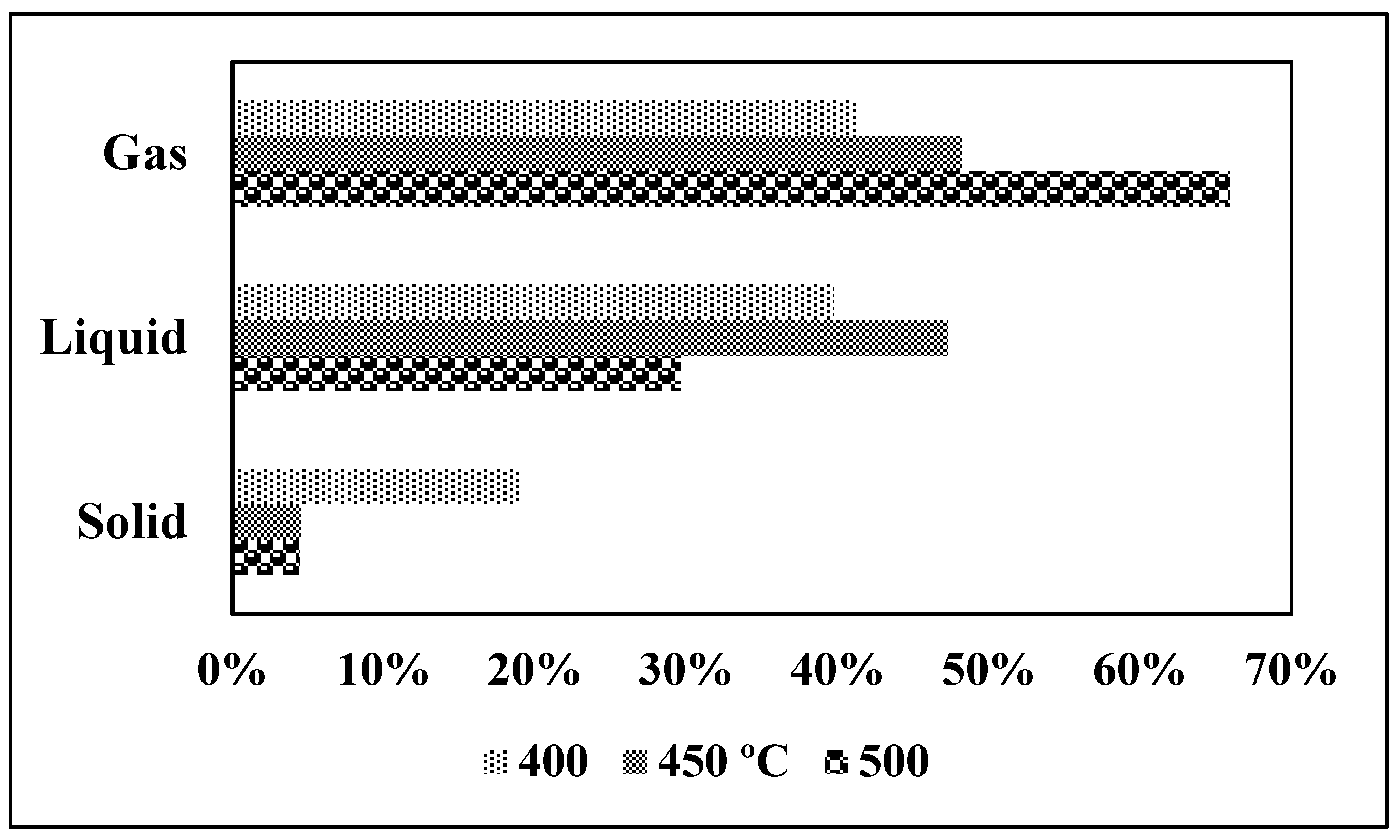
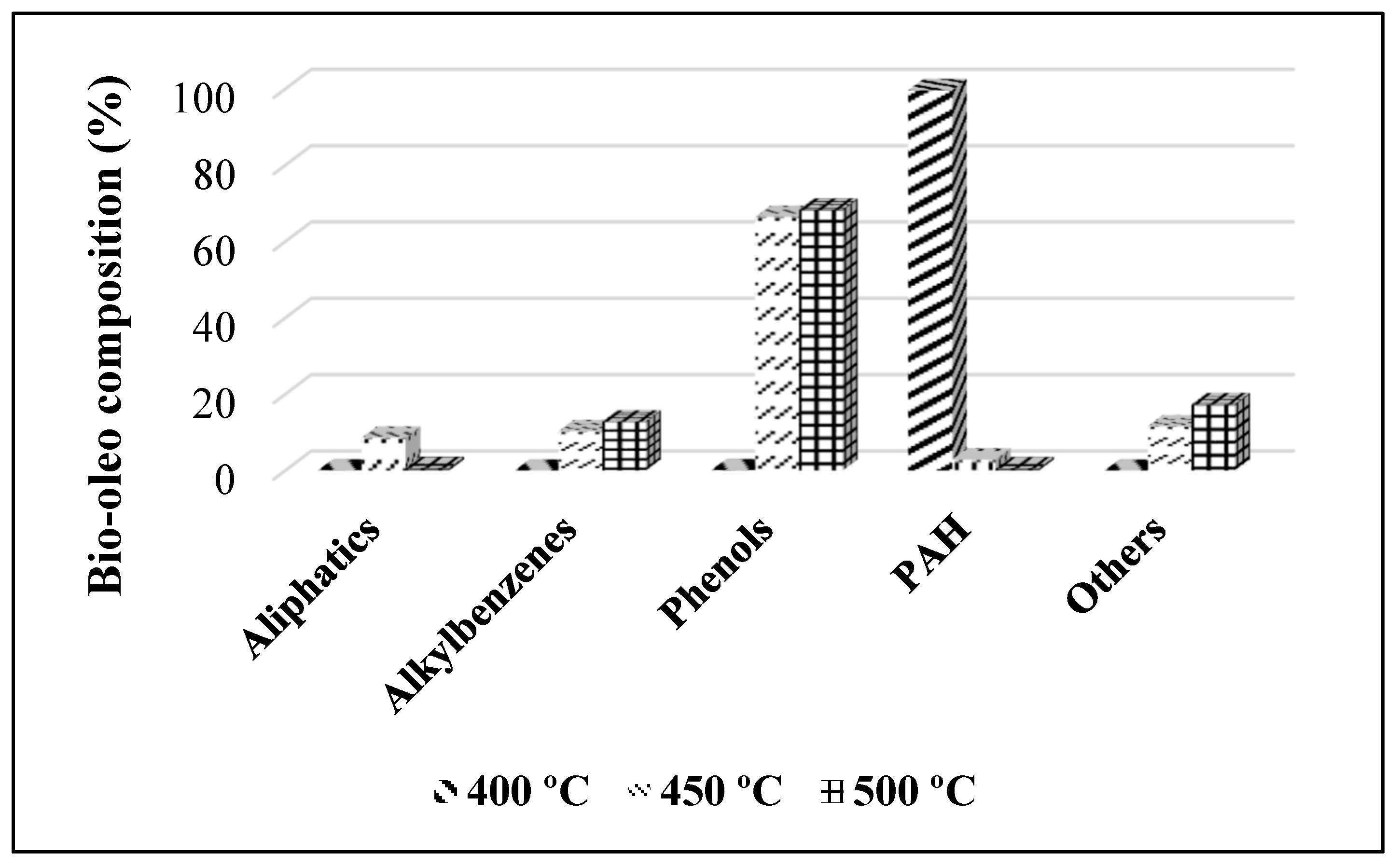

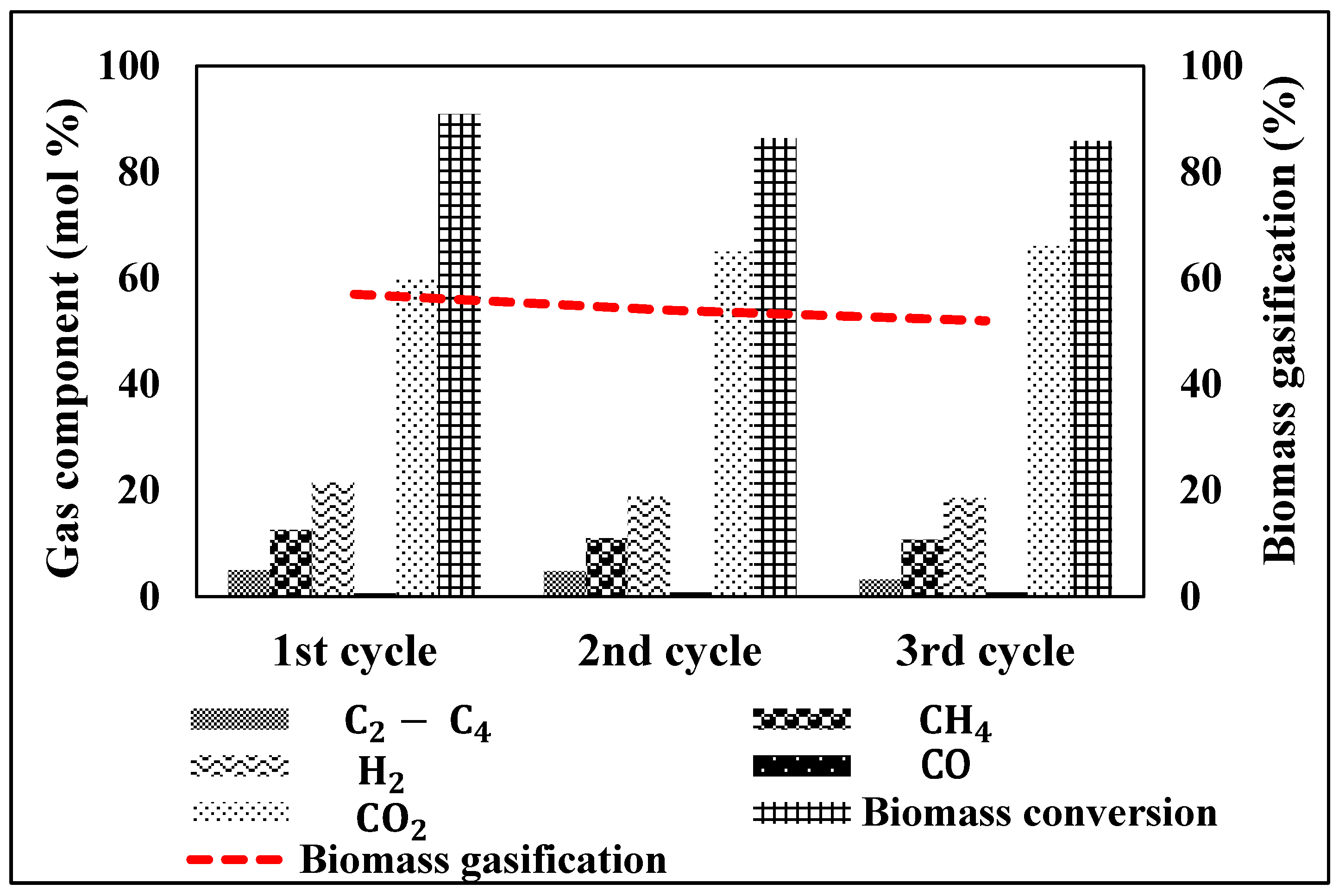
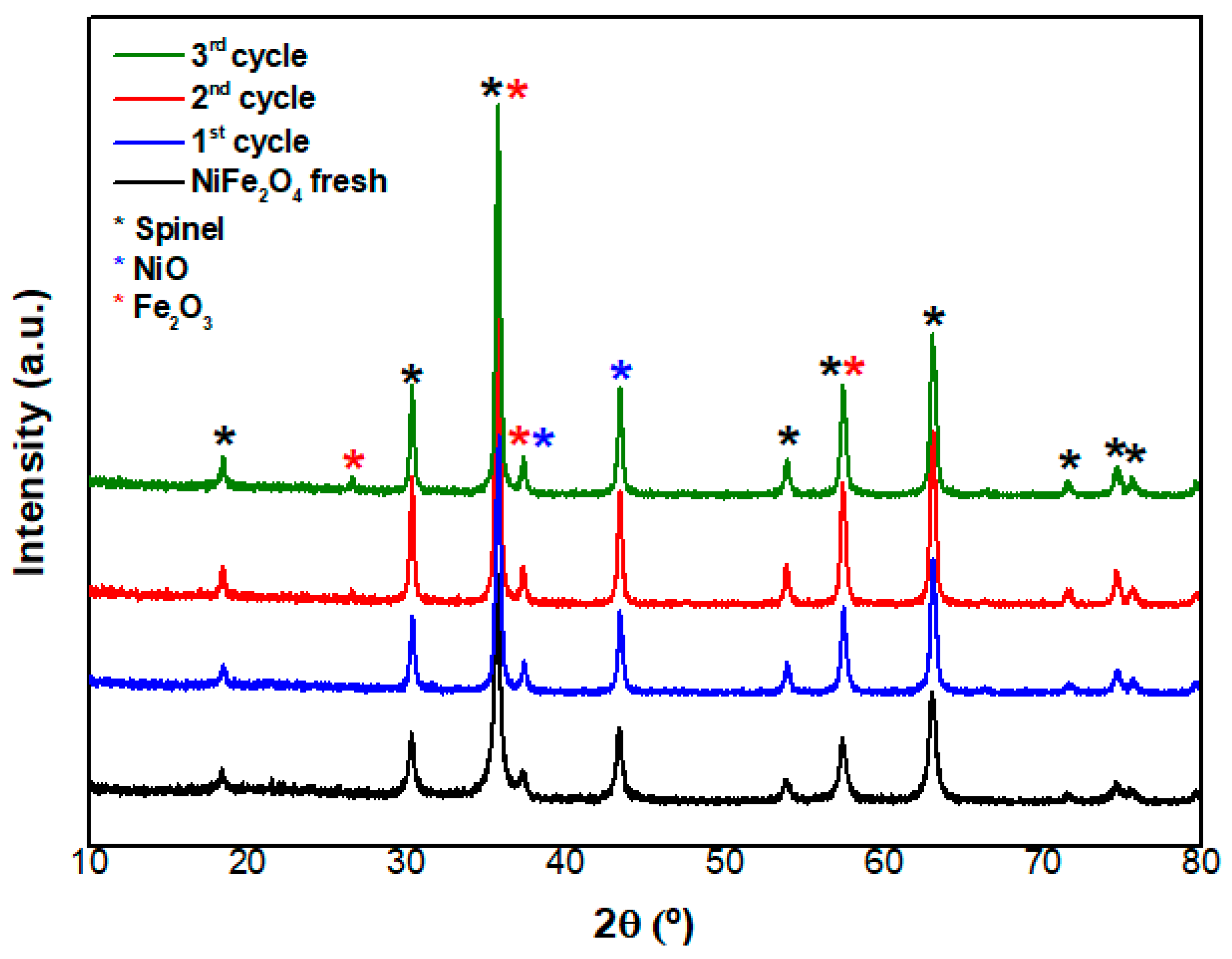
| Exp. | Temperature (°C) | Eucalyptus Wood Chips (g) | Catalyst (g) | Biomass Conversion (%) |
|---|---|---|---|---|
| Test 1 | 400 | 2.223 | 1.998 | 81.09 |
| Test 2 | 450 | 2.216 | - | 72.73 |
| Test 3 | 2.199 | 1.001 | 84.93 | |
| Test 4 | 2.201 | 2.005 | 95.49 | |
| Test 5 | 500 | 2.198 | - | 73.09 |
| Test 6 | 2.207 | 0.999 | 85.23 | |
| Test 7 | 2.225 | 1.999 | 95.56 |
| Exp. | Gas Component (mol%) | ||||
|---|---|---|---|---|---|
| H2 | CO | CO2 | CH4 | C2–C4 | |
| Test 1 | 9.52 | 2.27 | 75.81 | 9.15 | 3.07 |
| Test 2 | 13.72 | 6.56 | 51.85 | 21.72 | 5.85 |
| Test 3 | 18.10 | 0.70 | 61.65 | 14.53 | 4.85 |
| Test 4 | 25.05 | 0.65 | 56.22 | 13.55 | 4.36 |
| Test 5 | 14.90 | 2.56 | 40.83 | 34.52 | 7.02 |
| Test 6 | 19.10 | 0.50 | 49.50 | 24.07 | 6.47 |
| Test 7 | 20.19 | 0.53 | 49.73 | 23.11 | 6.31 |
| Phase | Sample | |||
|---|---|---|---|---|
| NiFe2O4 | NiFe2O4 | NiFe2O4 | NiFe2O4 | |
| Fresh | 1st Cycle | 2nd Cycle | 3rd Cycle | |
| NiFe2O4 | 38.6 | 45.5 | 48.5 | 51.0 |
| NiO | 33.7 | 32.7 | 32.3 | 30.0 |
| Fe2O3 | 27.7 | 21.8 | 19.2 | 19.0 |
| NiFe2O4 Crystallite Size (nm) | 18.11 | 23.18 | 26.73 | 28.09 |
© 2020 by the authors. Licensee MDPI, Basel, Switzerland. This article is an open access article distributed under the terms and conditions of the Creative Commons Attribution (CC BY) license (http://creativecommons.org/licenses/by/4.0/).
Share and Cite
Borges, A.C.P.; Onwudili, J.A.; Andrade, H.; Alves, C.; Ingram, A.; Vieira de Melo, S.; Torres, E. Catalytic Properties and Recycling of NiFe2O4 Catalyst for Hydrogen Production by Supercritical Water Gasification of Eucalyptus Wood Chips. Energies 2020, 13, 4553. https://doi.org/10.3390/en13174553
Borges ACP, Onwudili JA, Andrade H, Alves C, Ingram A, Vieira de Melo S, Torres E. Catalytic Properties and Recycling of NiFe2O4 Catalyst for Hydrogen Production by Supercritical Water Gasification of Eucalyptus Wood Chips. Energies. 2020; 13(17):4553. https://doi.org/10.3390/en13174553
Chicago/Turabian StyleBorges, Ane Caroline Pereira, Jude Azubuike Onwudili, Heloysa Andrade, Carine Alves, Andrew Ingram, Silvio Vieira de Melo, and Ednildo Torres. 2020. "Catalytic Properties and Recycling of NiFe2O4 Catalyst for Hydrogen Production by Supercritical Water Gasification of Eucalyptus Wood Chips" Energies 13, no. 17: 4553. https://doi.org/10.3390/en13174553
APA StyleBorges, A. C. P., Onwudili, J. A., Andrade, H., Alves, C., Ingram, A., Vieira de Melo, S., & Torres, E. (2020). Catalytic Properties and Recycling of NiFe2O4 Catalyst for Hydrogen Production by Supercritical Water Gasification of Eucalyptus Wood Chips. Energies, 13(17), 4553. https://doi.org/10.3390/en13174553







